The Birth of a New Hockey Era
Imagine a crisp winter night in the Midwest. The air is filled with anticipation as students, alumni, and hockey fans flock to their local arenas. Their excitement isn’t just for a regular game; they are here to witness a new chapter in college hockey history. The year was 2013, and the Big Ten Conference had just announced the formation of its hockey league. This wasn’t just another addition to the world of college sports—it was a game-changer, a league that would bring together some of the most storied programs in NCAA hockey.
The Big Ten Hockey League’s inception was a response to the growing popularity of college hockey. It was a bold move, consolidating six teams from the Midwest and East Coast with a rich history of competitive play. This new league promised to bring more exposure, better competition, and a heightened sense of rivalry among the teams. It wasn’t long before the Big Ten Hockey League became synonymous with high-level collegiate hockey, drawing attention from scouts, media, and fans nationwide.
Now, over a decade later, the Big Ten Hockey League stands as one of the premier conferences in college hockey. With teams consistently ranking among the top in the NCAA, the league has fulfilled its promise of intense competition and thrilling matchups. This article will take you through the history, teams, and impact of the Big Ten Hockey League, showcasing why it has become a cornerstone of college hockey.
The Formation of the Big Ten Hockey League
Background and Development
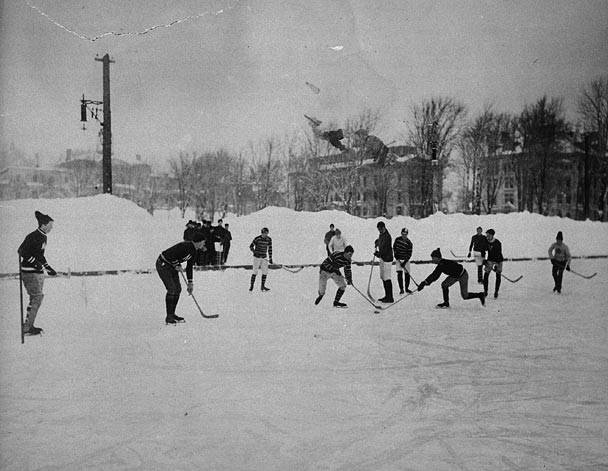
The Big Ten Hockey League was officially formed in 2013, but its roots go back much further. Before the league’s formation, the six founding teams were spread across various conferences. Michigan, Michigan State, and Ohio State were members of the Central Collegiate Hockey Association (CCHA), while Minnesota and Wisconsin were part of the Western Collegiate Hockey Association (WCHA). Penn State, the newest addition, had just elevated its hockey program to the Division I level in 2012.
The decision to form a new league was driven by the Big Ten Conference’s desire to capitalize on its brand and create a unified hockey conference. With the addition of Penn State, the Big Ten had the minimum six teams required to form a new conference under NCAA rules. The move was also influenced by the desire to increase television exposure, as the Big Ten Network could now broadcast hockey games nationwide, providing the league with a significant platform.
Timeline of Key Events
- 2011: The announcement of Penn State’s move to Division I hockey sparks discussions about forming a Big Ten Hockey League.
- 2013: The Big Ten Hockey League officially begins play with six teams: Michigan, Michigan State, Minnesota, Ohio State, Penn State, and Wisconsin.
- 2017: Notre Dame joins the Big Ten Hockey League as an affiliate member, further enhancing the league’s competitiveness.
- 2020: The COVID-19 pandemic impacts the league, leading to a modified schedule and limited fan attendance.
- 2023: The Big Ten Hockey League celebrates its 10th anniversary, solidifying its reputation as a top-tier college hockey conference.
The Impact of the League’s Formation
The formation of the Big Ten Hockey League had a profound impact on college hockey. It led to a realignment of conferences, with teams like Minnesota and Wisconsin leaving the WCHA and Michigan, Michigan State, and Ohio State departing the CCHA. The Big Ten Hockey League brought increased visibility to college hockey, as games were regularly broadcast on the Big Ten Network. This exposure helped elevate the sport’s profile, attracting more fans and leading to increased attendance at games.
Teams of the Big Ten Hockey League
Michigan Wolverines
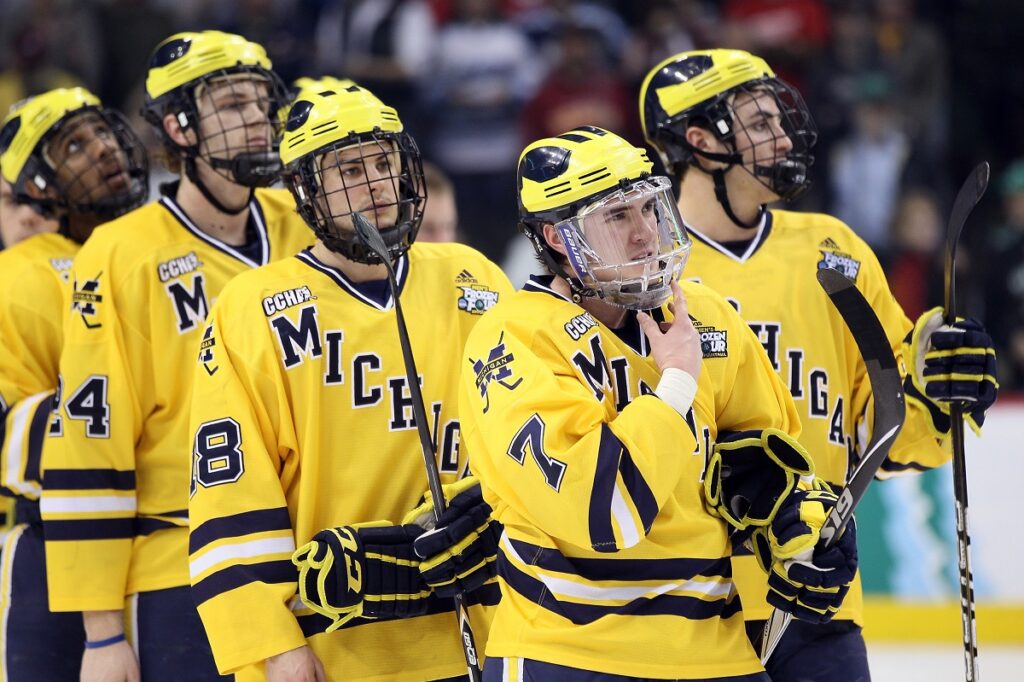
The Michigan Wolverines are one of the most storied programs in college hockey. With nine NCAA championships, the Wolverines have a rich history of success. Michigan has produced numerous NHL players and is known for its passionate fan base and iconic Yost Ice Arena.
- Location: Ann Arbor, Michigan
- NCAA Championships: 9
- Notable NHL Alumni: Red Berenson, Marty Turco, Jack Johnson
Minnesota Golden Gophers

The Minnesota Golden Gophers are another powerhouse in college hockey, with five NCAA championships to their name. Known for their speed and skill, the Gophers have consistently been a top team in the Big Ten Hockey League.
- Location: Minneapolis, Minnesota
- NCAA Championships: 5
- Notable NHL Alumni: Neal Broten, Phil Housley, Blake Wheeler
Wisconsin Badgers
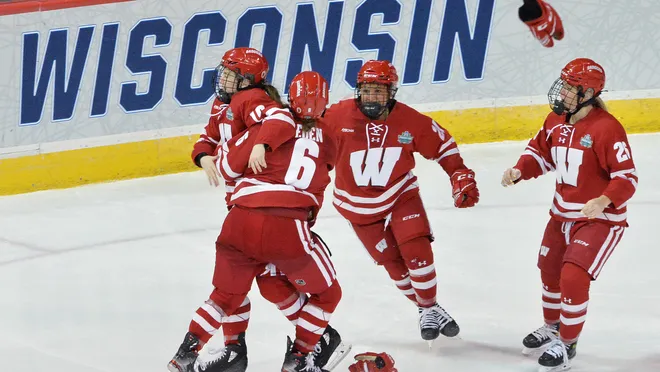
The Wisconsin Badgers have a proud hockey tradition, with six NCAA championships. The Badgers play their home games at the Kohl Center, one of the largest arenas in college hockey, and are known for their strong fan support.
- Location: Madison, Wisconsin
- NCAA Championships: 6
- Notable NHL Alumni: Chris Chelios, Ryan Suter, Joe Pavelski
Ohio State Buckeyes
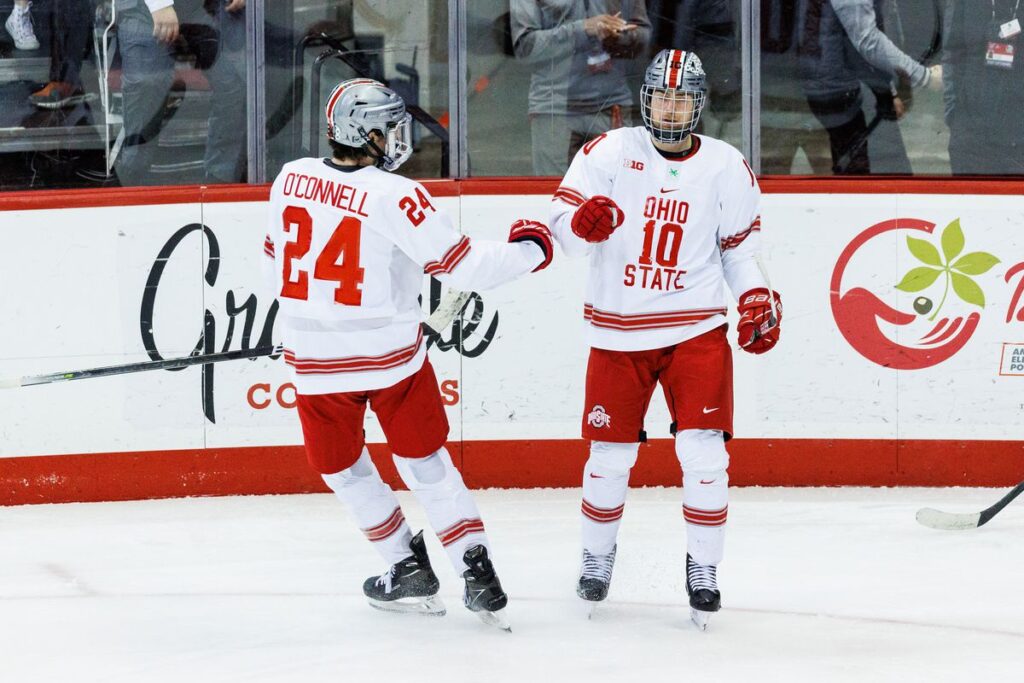
The Ohio State Buckeyes may not have the same historical success as Michigan or Minnesota, but they have become a formidable team in the Big Ten Hockey League. The Buckeyes reached the Frozen Four in 2018, marking a significant achievement for the program. Read more about the Harrow Hockey Tournament 2024.
- Location: Columbus, Ohio
- NCAA Championships: 0
- Notable NHL Alumni: R.J. Umberger, Ryan Kesler, Nick Foligno
Michigan State Spartans
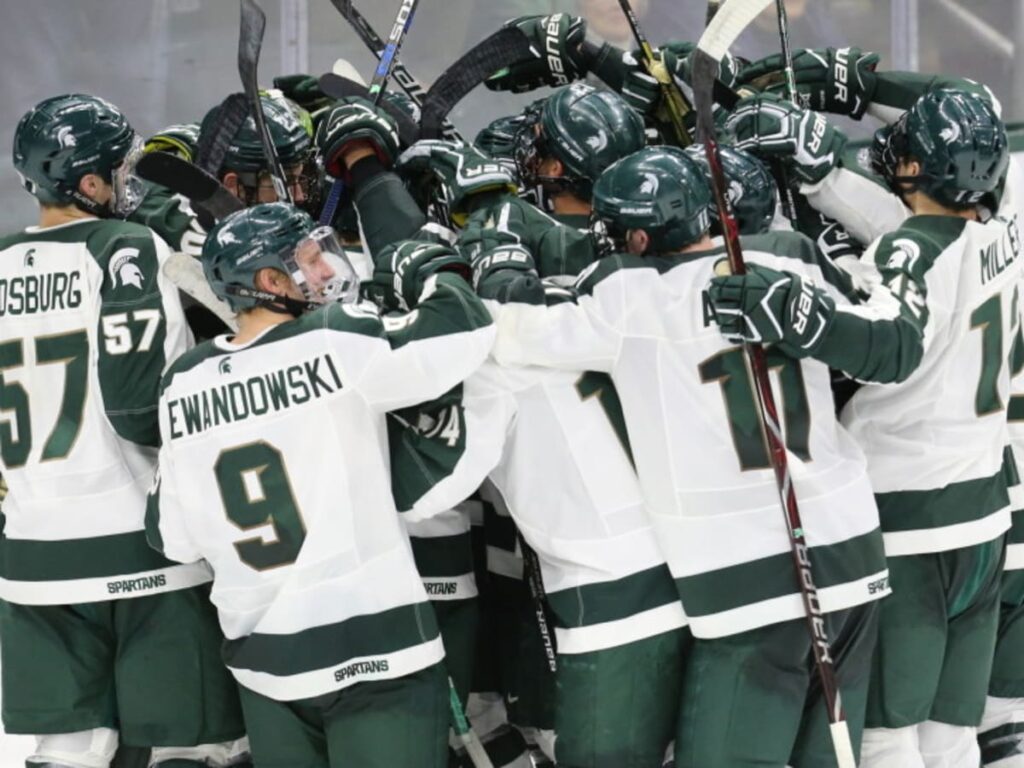
The Michigan State Spartans have a rich hockey history, with three NCAA championships. The Spartans are known for their physical style of play and have a passionate fan base that fills Munn Ice Arena.
- Location: East Lansing, Michigan
- NCAA Championships: 3
- Notable NHL Alumni: Rod Brind’Amour, Duncan Keith, Torey Krug
Penn State Nittany Lions
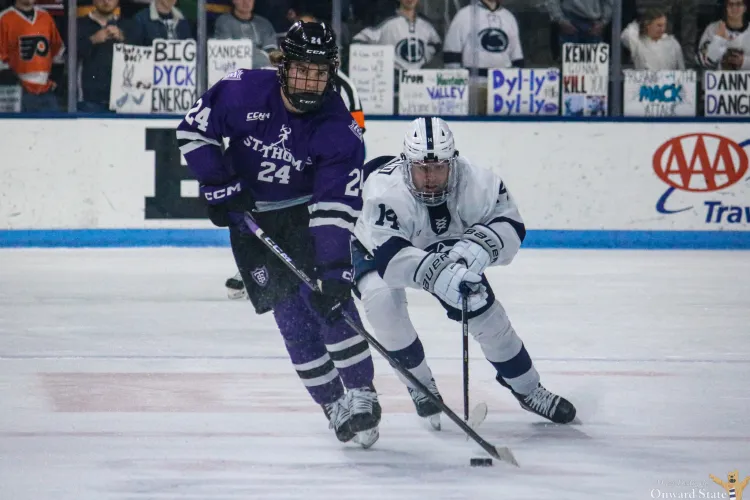
The Penn State Nittany Lions are the newest team in the Big Ten Hockey League, having elevated their program to Division I in 2012. Despite their relative youth, the Nittany Lions have quickly become a competitive team known for their high-octane offense.
- Location: University Park, Pennsylvania
- NCAA Championships: 0
- Notable NHL Alumni: None (as of 2024)
Notre Dame Fighting Irish (Affiliate Member)
Notre Dame joined the Big Ten Hockey League as an affiliate in 2017. The Fighting Irish have a strong hockey tradition, with multiple Frozen Four appearances. Notre Dame’s addition to the league has further enhanced the Big Ten’s competitiveness.
- Location: South Bend, Indiana
- NCAA Championships: 0
- Notable NHL Alumni: Anders Lee, Ian Cole, Vinnie Hinostroza
Team Statistics and Performance
Here’s a table summarizing the key statistics and performance of each team in the Big Ten Hockey League:
| Team | Location | NCAA Championships | Frozen Four Appearances | NHL Alumni (Notable) |
|---|---|---|---|---|
| Michigan Wolverines | Ann Arbor, Michigan | 9 | 25 | Red Berenson, Jack Johnson |
| Minnesota Golden Gophers | Minneapolis, Minnesota | 5 | 22 | Neal Broten, Blake Wheeler |
| Wisconsin Badgers | Madison, Wisconsin | 6 | 11 | Chris Chelios, Ryan Suter |
| Ohio State Buckeyes | Columbus, Ohio | 0 | 2 | R.J. Umberger, Ryan Kesler |
| Michigan State Spartans | East Lansing, Michigan | 3 | 11 | Rod Brind’Amour, Torey Krug |
| Penn State Nittany Lions | University Park, Pennsylvania | 0 | 0 | None |
| Notre Dame Fighting Irish (Affiliate) | South Bend, Indiana | 0 | 4 | Anders Lee, Ian Cole |
Key Rivalries in the Big Ten Hockey League
Michigan vs. Michigan State: The Battle for Michigan
One of the fiercest rivalries in college hockey is between the Michigan Wolverines and the Michigan State Spartans. Known as the “Battle for Michigan,” this rivalry dates back to 1922. The intensity of these matchups is unparalleled, with both teams’ fans eagerly anticipating their annual meetings. The rivalry is marked by close games, dramatic finishes, and a deep-seated desire to claim bragging rights in the state.
Minnesota vs. Wisconsin: The Border Battle
The rivalry between the Minnesota Golden Gophers and the Wisconsin Badgers is one of the oldest in college hockey. Known as the “Border Battle,” this rivalry has been ongoing since 1922. Both teams have a strong hockey tradition, and fans always anticipate their games. The rivalry is characterized by its physicality, with both teams leaving everything on the ice.
Ohio State vs. Michigan: A Rivalry Across Sports
The rivalry between Ohio State and Michigan is one of the most famous in all sports, extending to hockey. While the rivalry is more prominent in football, the hockey matchups between these two teams are equally intense. The games are often close, with both teams striving to come out on top in this storied rivalry.
Notre Dame vs. Michigan: A New Rivalry
Notre Dame’s addition to the Big Ten Hockey League has sparked a new rivalry with Michigan. These two programs have a history of competitive games, and their match-ups have quickly become must-watch events. The rivalry between Notre Dame and Michigan is fueled by their proximity and history in other sports, making their hockey clashes a natural extension of this competitive relationship. Both teams have passionate fan bases, and the games are often filled with high drama and skillful play.
Penn State vs. Minnesota: A Clash of Styles
The rivalry between Penn State and Minnesota is relatively new but has grown in intensity. Penn State’s high-octane, offense-first approach contrasts with Minnesota’s more balanced and traditional hockey style. This clash of styles makes their games particularly exciting, as fans can expect a fast-paced and dynamic matchup. As Penn State continues to establish itself in the Big Ten Hockey League, this rivalry will likely become even more significant.
Wisconsin vs. Notre Dame: A Meeting of Powerhouses
The rivalry between Wisconsin and Notre Dame pits two historically strong programs against each other. Although Notre Dame is an affiliate member, its games against Wisconsin are always fiercely contested. Both teams have deep rosters and are known for their physical, defensive play. This rivalry showcases what makes the Big Ten Hockey League so competitive: every game has the potential to be a battle between elite teams.
The Big Ten Hockey League’s Impact on College Hockey
Increased Visibility and National Exposure
One of the most significant impacts of the Big Ten Hockey League has been the increased visibility of college hockey. The league’s formation allowed for more games to be broadcast on the Big Ten Network, which reaches a national audience. This exposure has helped grow the sport’s popularity, attracting new fans and increasing interest in college hockey across the country.
The Big Ten’s partnership with major sports networks has also led to more games being televised on platforms like ESPN and NBC Sports, further enhancing the league’s visibility. This national exposure has been beneficial not only for the teams in the Big Ten Hockey League but also for college hockey as a whole. With more eyes on the sport, college hockey has grown in attendance, viewership, and overall fan engagement.
Recruitment and Development of Talent
The Big Ten Hockey League has become a hotbed for recruiting top talent. The league’s prominence and competitive nature make it an attractive destination for high-level recruits who aspire to play in the NHL. The combination of excellent facilities, strong coaching staff, and the opportunity to play in a nationally recognized conference has made the Big Ten a prime destination for elite players.
Moreover, the Big Ten Hockey League has played a crucial role in the development of young talent. With multiple teams consistently ranked among the top programs in the NCAA, players in the Big Ten are exposed to high-level competition on a regular basis. This environment helps prepare them for the rigors of professional hockey, and many Big Ten players have successfully transitioned to the NHL.
Impact on Conference Realignment
The formation of the Big Ten Hockey League also had a ripple effect on conference realignment in college hockey. With the departure of Michigan, Michigan State, and Ohio State from the CCHA, and Minnesota and Wisconsin from the WCHA, other conferences had to adapt. The dissolution of the CCHA and the reshuffling of teams in the WCHA and other conferences were direct consequences of the Big Ten’s emergence.
While this realignment caused some initial disruption, it ultimately led to a more balanced and competitive landscape in college hockey. The Big Ten’s success has inspired other conferences to strengthen their own programs, leading to increased competition across the board.
The Role of the Big Ten Hockey Tournament
The Big Ten Hockey Tournament is the league’s premier event, bringing together all the teams for a single-elimination tournament to determine the conference champion. Since its inception, the tournament has been a showcase of the league’s talent and competitiveness. The tournament’s winner receives an automatic bid to the NCAA Tournament, making it a critical event for teams looking to secure their spot in the national championship race.
The tournament has been held at various neutral sites, including Detroit’s Joe Louis Arena and Minneapolis’s Xcel Energy Center, providing fans from across the region an opportunity to attend. The Big Ten Hockey Tournament has become a staple of the college hockey postseason, with intense matchups and memorable moments every year.
Notable Moments in Big Ten Hockey History
The Big Ten Hockey League may be relatively young, but it has already produced several memorable moments that have left a lasting impact on college hockey. Some of the most notable moments include:
- 2014 Big Ten Championship: In the league’s inaugural season, the Wisconsin Badgers won the first-ever Big Ten Hockey Tournament, defeating Ohio State in the championship game. This victory solidified Wisconsin’s place as a top program in the new league.
- 2018 Ohio State’s Frozen Four Run: The Ohio State Buckeyes made a historic run to the Frozen Four in 2018, marking their first appearance in the national semifinals since 1998. Their success was a testament to the growing strength of the Big Ten Hockey League.
- 2019 Minnesota’s Regular-Season Title: The Minnesota Golden Gophers captured the Big Ten regular-season title in 2019, edging out rival Notre Dame in a thrilling race. Their consistency throughout the season highlighted their dominance in the conference.
- 2021 Michigan’s Return to the Frozen Four: The Michigan Wolverines returned to the Frozen Four in 2021 after a long absence. Their run was fueled by a roster loaded with NHL talent, showcasing the league’s ability to develop top-tier players.
- 2023 Penn State’s Breakthrough Season: Penn State had its best season yet in 2023, finishing near the top of the Big Ten standings and making a deep run in the NCAA Tournament. Their success marked a significant milestone for the program and the league.
Big Ten Hockey and the NHL Connection
Development Pipeline
The Big Ten Hockey League has established itself as a significant pipeline to the NHL. Many players from the league have been drafted into the NHL, and several have gone on to have successful professional careers. The combination of high-level competition and excellent coaching in the Big Ten has made it an ideal environment for developing future NHL stars.
Notable NHL Alumni
Several notable NHL players have come through the Big Ten Hockey League, and their success at the professional level has helped raise the league’s profile. Some of the most prominent NHL alumni from the Big Ten include:
- Dylan Larkin (Michigan): A standout at the University of Michigan, Larkin has become one of the Detroit Red Wings’ top players and is the team’s captain.
- Blake Wheeler (Minnesota): Wheeler, a former Minnesota Golden Gopher, has enjoyed a successful NHL career, including serving as the captain of the Winnipeg Jets.
- Ryan Suter (Wisconsin): Suter, a former Wisconsin Badger, has had a long and distinguished NHL career, known for his solid defensive play.
- Kyle Connor (Michigan): After an impressive freshman season at Michigan, Connor quickly impacted the NHL and has become a key player for the Winnipeg Jets.
NHL Draft and Big Ten Representation
Each year, several players from the Big Ten Hockey League are selected by NHL teams in the NHL Draft. The league’s representation in the draft has been consistently strong, with multiple first-round picks coming from Big Ten programs. This trend underscores the league’s reputation as a breeding ground for future NHL talent.
Here’s a table summarizing the number of Big Ten players selected in the NHL Draft from 2014 to 2023:
| Year | Number of Big Ten Players Drafted | First-Round Picks |
|---|---|---|
| 2014 | 12 | 2 |
| 2015 | 14 | 3 |
| 2016 | 10 | 1 |
| 2017 | 15 | 4 |
| 2018 | 13 | 2 |
| 2019 | 11 | 3 |
| 2020 | 9 | 1 |
| 2021 | 16 | 5 |
| 2022 | 12 | 2 |
| 2023 | 14 | 3 |
The Future of Big Ten Hockey and the NHL
As the Big Ten Hockey League continues to grow, its connection to the NHL is likely to strengthen. The league’s reputation as a top collegiate hockey conference will continue to attract elite talent, and its players will remain highly sought after in the NHL Draft. The success of Big Ten alumni in the NHL also serves as a powerful recruiting tool, as young players see the league as a direct path to professional success.
The Role of Coaches in the Big Ten Hockey League
Legendary Coaches and Their Impact
The Big Ten Hockey League has been home to some of the most respected coaches in college hockey. These coaches have not only led their teams to success but have also played a significant role in the development of their players.
Tony Granato (Wisconsin): Granato, a former NHL player and coach, has brought his extensive experience to the Wisconsin Badgers. Under his leadership, Wisconsin has continued to be a competitive force in the Big Ten Hockey League.
Red Berenson (Michigan): A legendary figure in college hockey, Berenson coached the Michigan Wolverines for over three decades, leading the team to two NCAA championships. His influence on the program and his ability to develop NHL talent are unmatched.
Don Lucia (Minnesota): Lucia served as the head coach of the Minnesota Golden Gophers for 19 years, winning two national championships. His tenure at Minnesota solidified the program’s place as one of the elite in college hockey.
Jeff Jackson (Notre Dame): Jackson has been the head coach of the Notre Dame Fighting Irish since 2005 and has led the team to multiple Frozen Four appearances. His strategic acumen and player development skills have made Notre Dame a perennial contender.
The Importance of Coaching in the Big Ten Hockey League cannot be overstated.
Coaches in this league are responsible for developing game strategies and shaping the careers and futures of their players. Their role extends beyond the ice, as they mentor young athletes, instill values of teamwork and discipline, and prepare them for potential professional careers.
Coaching Styles and Their Influence
Each coach in the Big Ten brings a unique style and philosophy to their team. These coaching styles significantly influence how their teams play and how players develop throughout their college careers.
- Red Berenson’s Offensive Prowess: Known for emphasizing offensive creativity and speed, Berenson’s Michigan teams were always among the highest-scoring in college hockey. His approach allowed players like Dylan Larkin and Kyle Connor to thrive and develop into top NHL prospects.
- Don Lucia’s Balanced Approach: Lucia was known for balancing offense and defense, ensuring that his teams were strong in all areas of the game. This balanced approach made Minnesota a consistent contender, with players well-prepared for the demands of professional hockey.
- Jeff Jackson’s Defensive Mastery: Jackson has been a proponent of strong defensive systems, focusing on limiting opponents’ scoring chances while capitalizing on counter-attacks. His defensive-minded approach has made Notre Dame one of the toughest teams to play against in the Big Ten.
- Tony Granato’s NHL Experience: Granato brings a wealth of NHL experience to Wisconsin, and his coaching reflects that professional influence. He emphasizes physical play, defensive responsibility, and special teams, preparing his players for the next level of competition.
The Future of Coaching in the Big Ten Hockey League
As the Big Ten Hockey League continues to evolve, the role of coaching will remain critical. With new, young coaches entering the league and veteran coaches continuing to adapt their strategies, the Big Ten is poised to maintain its reputation as one of the top college hockey conferences. The continued development of players and the league’s ability to attract and retain top coaching talent will be key factors in its future success.
Big Ten Hockey League: Challenges and Opportunities
Challenges Facing the League
Despite its many successes, the Big Ten Hockey League faces several challenges that could impact its future growth and stability.
- Balancing Academics and Athletics: Like all college sports, hockey players in the Big Ten must balance their academic responsibilities with their athletic commitments. The rigorous academic standards of Big Ten institutions can be demanding, and maintaining this balance is crucial for the well-being and success of student-athletes.
- Competition from Other Conferences: While the Big Ten is one of the most prominent conferences in college hockey, it faces stiff competition from other conferences like the Hockey East, NCHC, and ECAC. These conferences also boast top programs and attract elite talent, making it challenging for the Big Ten to maintain its edge.
- Adapting to Changing NCAA Regulations: The NCAA is constantly evolving, with new regulations and rules that impact college sports. The Big Ten Hockey League must adapt to these changes, whether they involve player eligibility, recruitment practices, or the transfer portal. Staying ahead of these changes is essential for the league’s continued success.
Opportunities for Growth
Along with challenges, the Big Ten Hockey League also has several opportunities for growth and expansion.
- Expanding Membership: While the Big Ten currently consists of seven teams, there is potential for expansion. Adding more schools with strong hockey programs could further enhance the league’s competitiveness and geographic reach. Schools like Illinois and Northwestern have been rumored as potential candidates for starting Division I hockey programs, which could eventually join the Big Ten.
- Enhanced Marketing and Branding: The Big Ten has the advantage of being associated with a well-known and respected brand in college sports. Leveraging this brand through enhanced marketing efforts could help grow the league’s fan base, increase attendance, and attract more sponsors and media coverage.
- Strengthening Rivalries: Rivalries are a key component of sports culture, and the Big Ten Hockey League has several intense rivalries. By promoting these rivalries through special events, themed games, and targeted marketing, the league can increase fan engagement and viewership.
- Investing in Facilities: Many Big Ten schools already have state-of-the-art hockey facilities, but continued investment in arenas, training centers, and fan amenities can further elevate the game-day experience. Improved facilities can also be a powerful recruiting tool, attracting top talent to the league.
The Future Outlook for the Big Ten Hockey League
Looking ahead, the Big Ten Hockey League appears well-positioned for continued success. With a strong foundation, a passionate fan base, and the backing of a powerful conference, the league has the potential to remain a dominant force in college hockey. By addressing its challenges and seizing its opportunities, the Big Ten can continue to grow in stature and influence, solidifying its place as one of the premier college hockey conferences in the country.
Conclusion
The Big Ten Hockey League has quickly become a powerhouse in college hockey. From its formation in 2013 to its current status as one of the top conferences in the sport, the league has significantly impacted college hockey and the broader hockey landscape. With a rich history of rivalries, top-tier talent, and a strong connection to the NHL, the Big Ten Hockey League is poised to continue its success for years to come.
As the league looks to the future, it will face challenges, but the opportunities for growth and expansion are plentiful. With the continued support of its passionate fan base, the dedication of its coaches and players, and the backing of the Big Ten Conference, the Big Ten Hockey League is on a path to even greater achievements. Whether you’re a die-hard hockey fan or new to the sport, the Big Ten Hockey League offers some of the most exciting and competitive hockey you’ll find at the collegiate level.
Frequently Asked Questions (FAQs)
What is the Big Ten Hockey League?
The Big Ten Hockey League is a collegiate ice hockey conference that began play in the 2013-2014 season. It is part of the broader Big Ten Conference, which is one of the oldest and most prestigious athletic conferences in the United States. The hockey league consists of seven teams: Michigan, Michigan State, Minnesota, Ohio State, Penn State, Wisconsin, and Notre Dame (affiliate member).
How many teams are in the Big Ten Hockey League?
There are currently seven teams in the Big Ten Hockey League: Michigan, Michigan State, Minnesota, Ohio State, Penn State, Wisconsin, and Notre Dame, which is an affiliate member of the conference.
Which teams have won the Big Ten Hockey Tournament?
Since its inception, the Big Ten Hockey Tournament has seen several teams emerge as champions. Wisconsin won the inaugural tournament in 2014. Minnesota, Notre Dame, and Michigan have also won the tournament in subsequent years. The tournament winner receives an automatic bid to the NCAA Tournament, making it a critical event for teams looking to compete for the national championship.
How does the Big Ten Hockey League impact the NHL?
The Big Ten Hockey League has established itself as a key pipeline for the NHL. Many players from the league are drafted into the NHL each year, and several alumni have gone on to have successful professional careers. The high level of competition and quality of coaching in the Big Ten makes it an ideal environment for developing future NHL stars.
What is the significance of the Big Ten Hockey League’s rivalries?
Rivalries are an integral part of the Big Ten Hockey League’s identity. These rivalries, such as Michigan vs. Michigan State and Minnesota vs. Wisconsin, generate excitement and draw significant attention from fans and media. They are a major reason why the league has become so popular and competitive, as the games are often intense and highly anticipated.
What are the future prospects for the Big Ten Hockey League?
The future of the Big Ten Hockey League looks bright. With strong programs, a solid fan base, and continued national exposure, the league is well-positioned for growth. Potential expansion, enhanced marketing, and investment in facilities are just some of the opportunities that could further elevate the league’s status in the coming years.
